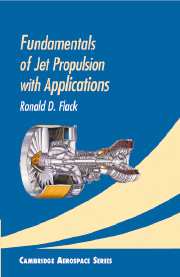Book contents
- Frontmatter
- Contents
- Preface
- Foreword
- Part I Cycle Analysis
- Part II Component Analysis
- 4 Diffusers
- 5 Nozzles
- 6 Axial Flow Compressors and Fans
- 7 Centrifugal Compressors
- 8 Axial Flow Turbines
- 9 Combustors and Afterburners
- 10 Ducts and Mixers
- Part III System Matching and Analysis
- Part IV Appendixes
- References
- Answers to Selected Problems
- Index
7 - Centrifugal Compressors
Published online by Cambridge University Press: 05 June 2012
- Frontmatter
- Contents
- Preface
- Foreword
- Part I Cycle Analysis
- Part II Component Analysis
- 4 Diffusers
- 5 Nozzles
- 6 Axial Flow Compressors and Fans
- 7 Centrifugal Compressors
- 8 Axial Flow Turbines
- 9 Combustors and Afterburners
- 10 Ducts and Mixers
- Part III System Matching and Analysis
- Part IV Appendixes
- References
- Answers to Selected Problems
- Index
Summary
Introduction
As discussed in Chapter 6, the basic operating principle of a compressor is to impart kinetic energy to the working fluid by the means of some rotating blades and then to convert the increase in energy to an increase in total pressure. Axial flow compressors are covered in Chapter 6. These compressors are used on large engines and gas turbines. However, for small engines – particularly turboshafts and turboprops – centrifugal (or radial) compressors are used.
These compressors have higher single-stage pressure ratios than axial compressors (typically 2 to 4 compared with ~1.25). As a result, centrifugal compressors have lower cross-sectional flow areas per mass flow rate than do axial compressors. They also have larger diameters but shorter lengths per unit mass flow rate than do axial compressors. However, the rotating element (impeller) of the compressor is an integral unit of blades and a disk, and thus if one blade is damaged the entire unit is replaced. The weights of centrifugal units are approximately the same as for axial compressors used for the same application. They, however, demonstrate the characteristic of lower flow rates. As a result, they are physically small units with low flow rates, which makes them ideal for helicopter and small aircraft applications.
- Type
- Chapter
- Information
- Fundamentals of Jet Propulsion with Applications , pp. 374 - 405Publisher: Cambridge University PressPrint publication year: 2005



